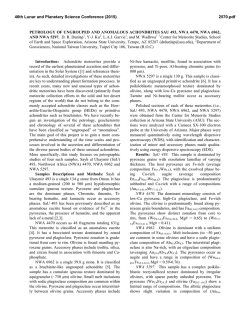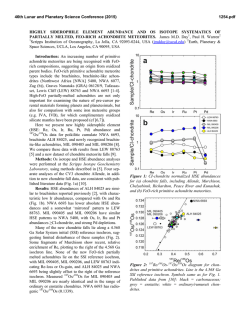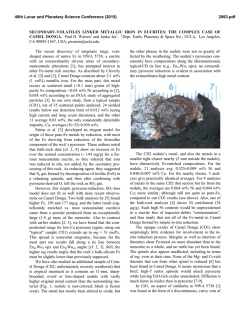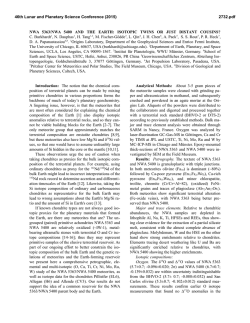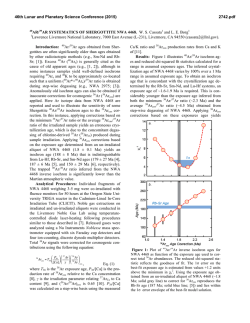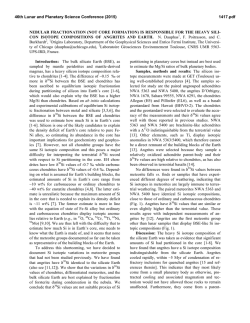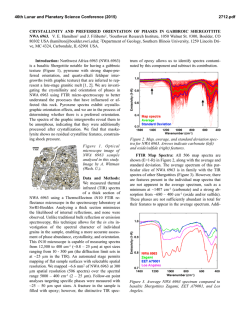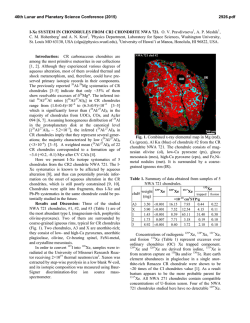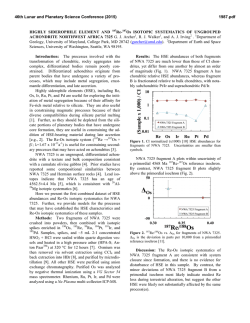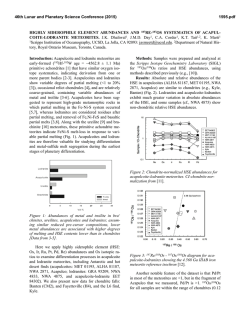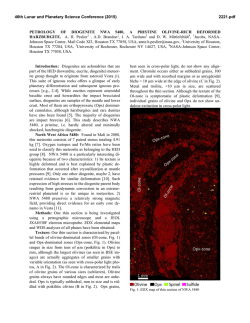
COMPARATIVE NON-DESTRUCTIVE STUDY OF THE ZAKLODZIE
46th Lunar and Planetary Science Conference (2015) 2817.pdf COMPARATIVE NON-DESTRUCTIVE STUDY OF THE ZAKLODZIE AND NWA 4301 ENSTATITE ACHONDRITES VIA MICRO-COMPUTED TOMOGRAPHY. D.D. Uribe1, P.J.A. McCausland1, M.R.M. Izawa2, R.L. Flemming1,J.U. Umoh3 and D.W. Holdsworth3 1Dept. of Earth Sciences, Western University, London, ON, N6A 5B7 [email protected];, 2 Dept. of Natural History, Royal Ontario Museum. 100 Queen's Park, Toronto, ON, Canada ;3Preclinical Imaging Research Center, Robarts, Research Institute Western University, London, ON, N6A3K9 current of 0.45 mA. Nine hundred views of data Introduction: Micro-computed tomography (µCT) were collected at an angular increment of 0.4 degrees serves as a useful tool for non-destructive analysis of around the object. The data were then reconstructed meteorite samples. It provides fully digitized 3D data into 3D image volume with an isotropic voxel size of of the internal density structures of rare and valuable 20 um. An eXplore speCZT scanner at peak energy of extraterrestrial materials without the samples being 110 kVp and the Nikon XT H 225 ST scanner at peak damaged [1].Investigating pristine meteorite samples is energy of 220 kVp for 90 minute scans were also used. not always possible as terrestrial weathering leads to Beam hardening was corrected using a custom calibraformation of alteration phases which are not repretion for the speCZT [3] and with a 1.5 copper filter for sentative of the original composition of the meteorite. the Nikon scanner. Reconstructed 3D volumes were µCT imaging of the interior of meteorites allows for processed using MicroView software. assessment of the degree of weathering variation withThreshold intensity ranges for metal and silicate in the sample, providing a context for future work. phases were chosen from a frequency vs. intensity hisIn µCT scans, volumetric proportions of some contogram in order to build a 3D isosurface of the metal stituents, typically, materials that have different X-ray and silicate phases and determine volume percent. Isoattenuation can be determined [e.g.2]. 3D isosurface surface determination consists of defining one or more rendering of high attenuation phases (i.e. metal and surfaces that mark the boundaries of the objects of sulphides) allows for 3D observation of metal distribuinterest, and in most cases these are assumed to corretion throughout the samples. This can be used to comspond to certain CT values [2]. pare not only physical characteristics but also volume In NWA 4301, intensity values ranging from modal percent comparison of different phases present. 1995 to 11995 HU were selected as the limits for siliMethods: The µCT data of the meteorites were accate phases and 12018 to 32768 HU for metal content, quired using the Locus scanner. The scanner operated from a frequency vs. intensity histogram, respectively. with an x-ray tube voltage of 80kVp and a tube In Zaklodzie intensity values of 6700 to Fig 1. Axial plane view CT image of Zaklodzie (a.) and NWA 4301 (b.). NWA 4301 in b. shows veining throughout and lower greyscale intensity values than Zaklodzie in a. Images c. and d. show line segment plot distance in mm vs. voxel intensity. Note low intensity values in d. reach 2000 voxel intensity compared to the low intensity values of 4000 in Zaklodzie as seen in c. 46th Lunar and Planetary Science Conference (2015) 32768 HU were chosen as limits for high density phases. Color intensity images along with line profiles were obtained for Zaklodzie and NWA 4301 to compare intensity values for silicate phases. 3D isosurfaces of the high intensity phases were reconstructed in order compare characteristics of the metal phases between samples (i.e. distribution, connectivity, size, shape). Discussion: Comparisons of µCT images and line profiles of NWA 4301 and Zaklodzie using the Locus scanner (Fig 1), show that NWA 4301 has generally lower intensity in the silicates than Zaklodzie. In Zaklodzie, most of the low intensity values representative of silicate phases have an average of 3600 HU whereas NWA 4301 has silicate intensity values that reach an average of 2800 HU. The lower voxel intensity for silicates in NWA 4301 appears to reflect a difference in weathering: Iron oxides of moderate voxel intensity appear to be widely distributed in Zaklodzie, affecting the silicate voxel intensity values, whereas iron oxides in NWA 4301 are found in distinct mm veins that can be resolved from the silicates. This difference may also be due to higher bulk iron content (will be tested with chemical analysis) in silicate grains content in NWA 4301 than Zaklodzie. b. b. a. c. c. c. b. d. d. d. Fig 2. Coronal view of NWA 4301 (a.) and Zaklodzie (b.). Areas highlighted in red represent high intensity phases. Images c. and d. show isosurface rendering of metal phases. Note: larger, more interconnected and elongated metal grains in NWA 4301 (a.) than in Zak (b.) 2817.pdf After selecting threshold value limits for silicates vs. metal phases, volume fractions were compared to reported modal content (Table 1). Fig 2 shows the high intensity phases in NWA 4301 (a.) and Zaklodzie (b.).The modal volume percent of high intensity phases from Fig 2 shows a small deviation from modal composition percent reported in [4] and [5]. Reported CT values Silicate + Metal + Low High plagioSulinten- intenclase phide sity sity NWA 80% 20% 79% 21% 4301 70% 30% 72% 28% Zaklodzie Table 1. Reported modal percent composition [4,5] vs. density low/high phases volume percent from µCT. Isosurface rendering of high intensity phases Fig 2c and 2d shows a difference in the distribution, size and shape of metal in NWA 4301 and Zaklodzie. The metal grains in NWA 4301 appear to be larger, elongated and interconnected throughout the meteorite. On the contrary, metal grains in Zaklodzie appear to be scattered, smaller and less interconnected than in NWA 4301. Summary: Comparison of µCT scans of the Zaklodzie and NWA 4301 meteorite reveal that silicate phases in NWA 4301 have lower intensity than Zaklodzie and metal grains seem to be more interconnected and larger than those seen in Zaklodzie as well. Additionally, both meteorites show distinct weathering profiles, where pervasive veining is dominant in NWA 4301 and Zaklodzie shows a metal content gradient from surface to interior. In summary, the use of µCT scans of meteorites is not only limited to viewing images in 2D but it is possible to reconstruct 3D isosurfaces of objects in question within the sample to examine the interior features of meteorites. This may be useful when selecting an area of the sample suitable for analysis (i.e. bulk chemical analysis ). Future work will involve comparing the intensity variation amongst samples through the use of different power source µCT scanners. References: [1] Uesugi. M. et al. (2010) Earth and Planetary Science Letters 299, 359-367; [2] Ketcham. A.K. and Carlson.W.D. (2001) Computers and Geosciences. 27, 381-400; [3] Edey,D.R. et al. (2013) 44th LPSC Abstract #2693; [4] Przylibski.T.A. et al. (2005) Meteoritics & Planetary Sci. 40. 182-200; [5] Connolly.H.C. et al. (2007). Meteoritics & Planetary Sci. 42,413-486.
© Copyright 2025
